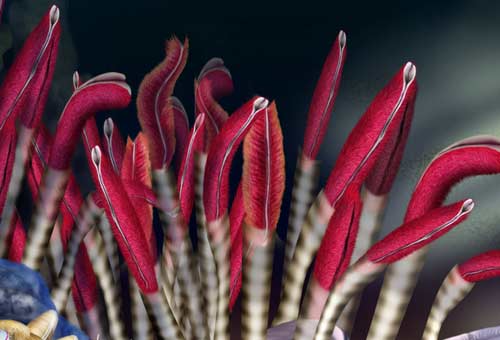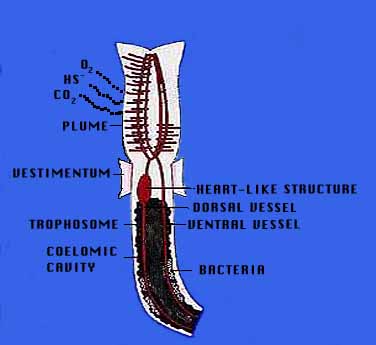Introduction
The worm under investigation on this website is Riftia pachyptila it was
discovered in 1969. It exists deep in the ocean near hydrothermal vents. It can
grow to over 2 meters. It is a worm with no mouth, no guts, and no anus. There is much debate to who to classify this guy. The
taxonomic status is still being determined. According to the Intigrated
Taxonomic Information System it is classified as such:
Domain
Eukaryota
Kingdom
Animalia
Phylum
Annelida
Class
Pogonophora
Order
Riftiida
Family
Rifiidae
Genus Riftia
Species Riftia pachyptila
Click on the thumbnail below to veiw my taxonomic tree.
Riftia has four body regions: the plume, the vestimentum, the coelomic cavity, and the trophosome.
The plume serves to diffuse nutrients and waste in and out of the worm with the outside environment. The vestimentum helps to anchor the upper portion of the worm in the tube. It provides a safe passage for the blood heading from the plume to the trophosome. The vestimentum also generates new tube material, holds reproductive pores, and houses the heart and brain(8).The trophosome is a special organ which houses the symbiotic bacteria where the tubeworm gets its nutrients. The coelomic cavity allows for the development of organs. One more important structure is the opisthosome which has some segmentation. As far as I'm aware this is the only connection that links this guy to the phylum annelida; everything else seem to be debatable depending on what scientific camp you're in.
Riftia pachyptila is super cool because in essence it doesn't need
food and doesn't poo. What could make for a better pet?
Disclaimer: This site is full of geeky scientific jargon and pictures, if you
get bored I will not be held responsible. Please Enjoy!


